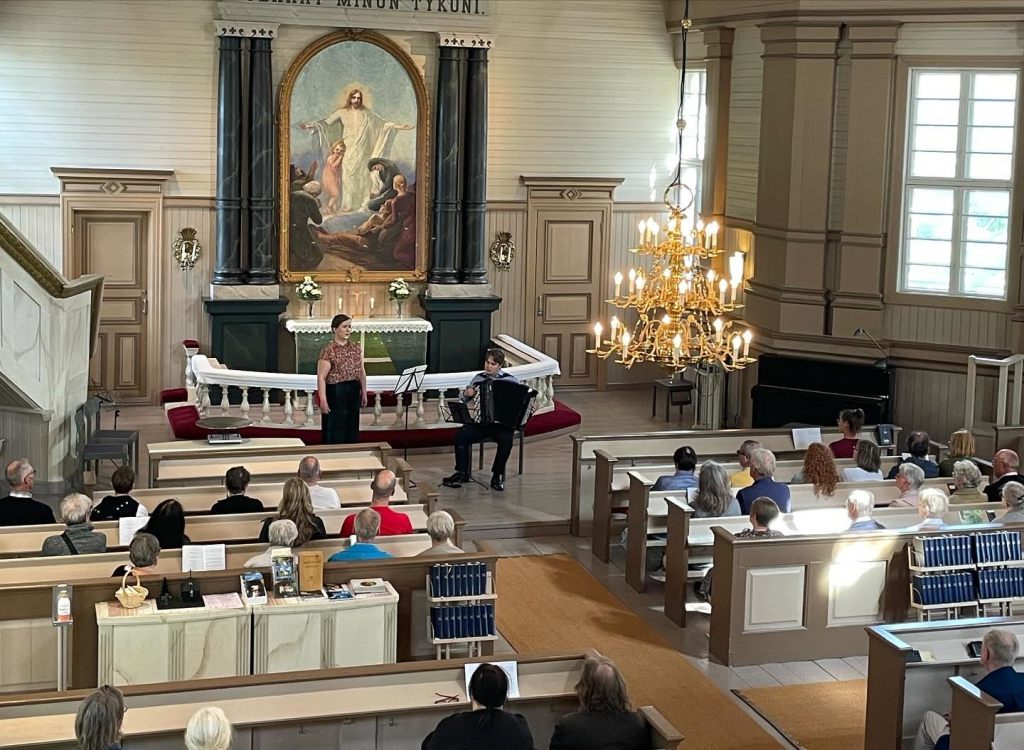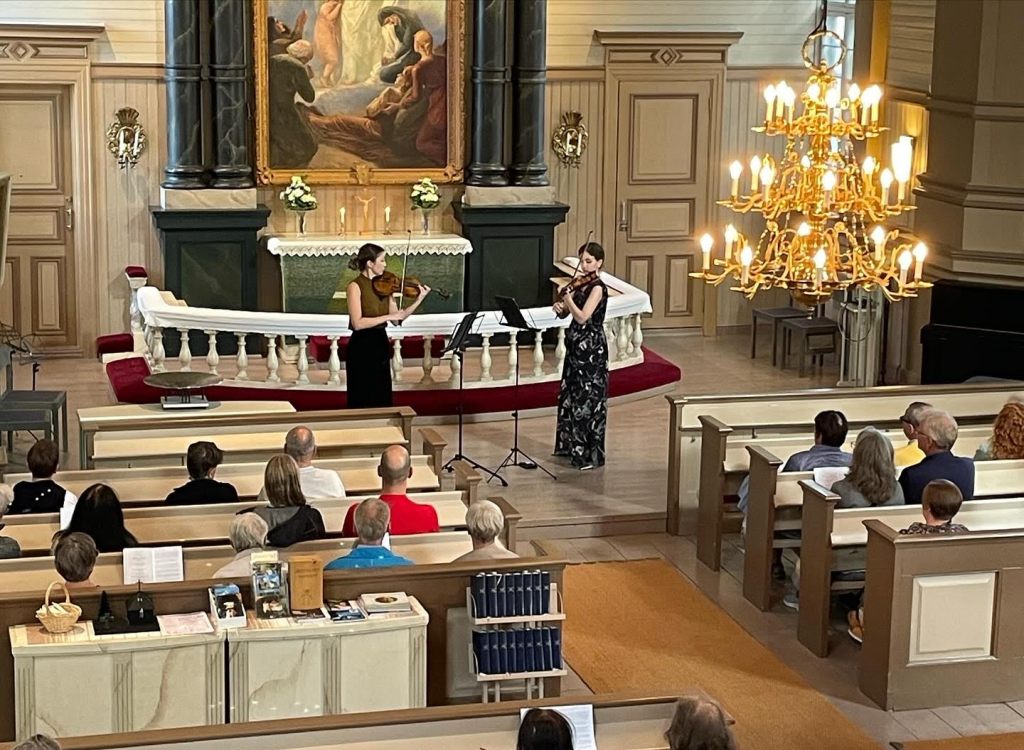
Assembled at Sahalahti Church on Saturday afternoon, the musicians of Kangasala Classic sounded out a remarkably well-devised programme of eight musical works from seven Nordic composers – six Finns and one Dane – bound together into seamless sonic flow of splendidly integrated stylistic diversity.
Heard as the afternoon’s preamble, Einar Englund’s Arioso interrotto (1979) is an appealing five-minute miniature in ABA form, opening with a sequence of airy meditation, contrasted by gently Bartókian central section and concluding with a contemplative recurrence of the main arioso. Originally written for violin solo, the music lends itself beautifully to viola, as demonstrated by Saara Kurki’s uplifting performance.
Keeping up with the elegiac mood and adding further contrast, Aulis Sallinen’s String Quartet No. 3 (1969) was given in focused outing by Rebecca Roozeman and Anna Husgafvel, violins, Elina Heikkinen, viola, and Artturi Aalto, cello. One of the composer’s most beloved works, better known by its proper title Some Aspects of Peltoniemi Hintrik’s Funeral March, the ca. twelve-minute quartet in one movement was initially devised for pedagogic purposes, displaying the art of variation form. However, the score soon found its place in the concert hall repertoire, thanks to Sallinen’s witty musical treatments on the Finnish folk tune.
In context of Sallinen’s stylistic development, Some Aspects of Peltoniemi Hintrik’s Funeral March is enveloped by the composer’s Canzona (1960) and Quiet Songs (1971) second and fourth quartets, all cast in pensive, single-movement form, building upon gradual motivic development. Speaking in broader terms, all three works demonstrate different stages in Sallinen’s transformative journey from mainstream modernism towards highly personal and more inclusive musical style.
Despite its funereal undercurrents, the quartet’s emotional landscape is far from dead serious – in fact, there’s a lot of dead pan humor embedded, perhaps paying homage to the many raiments of the original folk melody, which, after all, was initially known as a wedding tune. In any case, Sallinen’s score is one to engage audiences wherever it is played, and the Sahalahti church was no exception. Well received and much talked about during the intermission, the quartet cast its charms over the audience, whose enthusiasm was undoubtably enhanced by the presentation of the original tune, heard before the quartet performance from the organ gallery, accounted by soprano Meeri Pulakka and accordionist Janne Valkeajoki.
Concluding the first half, Valkeajoki and cellist Samuli Peltonen delivered a wonderful reading of Ilkka Kuusisto’s Hymns (2000), one of the composer’s many musical gems. As suggested by its title, the score consists of three short movements based on Latin hymns, recast as resplendent instrumental duets, opening with Coelestis aulae nuntius and segueing into Salve Regina. In the rousing Gloria finale, powerhouse elations frame a refined central section, where the text is sung by the cellist.
Introducing the second half, Pulakka and Valkeajoki gave a mesmerizing account of Minna Leinonen’s When the sun goes down (2007) for soprano and accordion from the song cycle Shom and setting a Bengalese text. Emerging from the vibrating air itself, the music opens on flickering, long-held accordion lines, joined by soprano voice. These simple aural events develop into soaring stanzas of utmost meditative focus, clad in twilight harmonies. As the text unfolds, the sung part and the accordion textures gradually meld into candle-lit sonic fields of vague shapes, before evaporating into darkness, echoed by brief accordion postlude. A small revelation, no less.
Keeping the mood going, Kasper Rofelt’s five-minuteNightsong (2008) for violin and accordion stems from folk-like introductory material, out of which a gentle nocturne emerges. As the music develops, its nightly calm is soon interrupted by subtly poignant pizzicato passage, which, in turn, gives way to more elegiac ruminations, thus completing the cycle. Splendidly performed by Husgafvel and Valkeajoki, Nightsong served as befitting interlude.

Given in captivating performance by Tami Pohjola and Rebecca Roozeman, Erkki Salmenhaara’s wistfully minimalistSonatina (1972) for two violins is a twelve minute study, opening on second violin’s airy, repeated lines, joined by first violin. Out of the dialogue, more pronounced melodic shapes arise, their contours enhanced by reiterations and gradual transformations in texture and dynamics. Halfway into the musical arch, more agitated statements are heard, followed by passages of intense contemplation. On the closing pages, the music finds its way back to its opening, landing on proto-Arvo Pärt gestures.
The afternoon’s second interlude, Jean Sibelius’s Valse triste (1903/1904) was gorgeously served by Valkeajoki, whose accordion take on the composer’s piano adaptation ranked among the finest readings of this age-old classic, setting the stage for the concluding tour de force of Sallinen’s brilliant Die Virtuose Tafelmusik von Don Juanquijote (2011) for violincello and accordion. In the score, the composer resorts to five-minute fast-cut reimagining of his concertante masterpiece The Nocturnal Dances of Don Juanquixote, op. 58 (1986) for solo cello and string orchestra, both written for the Finnish cello legend Arto Noras.
In the Tafelmusik version, one hears the familiar dance sequence in its compressed raiments, giving rise to a splendidly intoxicating night-club tableau, performed with breathtaking virtuosity and incessant energy by Peltonen and Valkeajoki, whose teamwork was simply admirable. Bringing the house down, Die Virtuose Tafelmusik von Don Juanquijote came off as finale par excellence.
As an encore treat, Valkeajoki gave a full-throttled reading of Lasse Pihlajamaa’s iconic Rumanian Rhapsody, thus presenting the audience with a joyful parting gift.
Kangasala Classic
Janne Valkeajoki, accordion
Meeri Pulakka, soprano
Tami Pohjola, violin
Rebecca Roozeman, violin
Anna Husgafvel, violin
Saara Kurki, viola
Elina Heikkinen, viola
Artturi Aalto, cello
Samuli Peltonen, cello
Einar Englund: Arioso interrotto (1979) for viola solo
Aulis Sallinen: Some Aspects of Peltoniemi Hintrik’s Funeral March – String Quartet No. 3 (1969)
Ilkka Kuusisto: Hymns (2000) for violoncello and accordion
Minna Leinonen: When the sun goes down from Two Songs from Shom (2007) for female voice and accordion
Kasper Rofelt: Nightsong, version 2 (2008) for violin and accordion
Erkki Salmenhaara: Sonatina (1972) for two violins
Jean Sibelius: Valse triste (1903/1904) for accordion solo
Aulis Sallinen: Die Virtuose Tafelmusik von Don Juanquijote (2011) for violincello and accordion
Sahalahti Church, Kangasala, Finland
Saturday 15 June, 3 pm
© Jari Kallio
Leave a comment